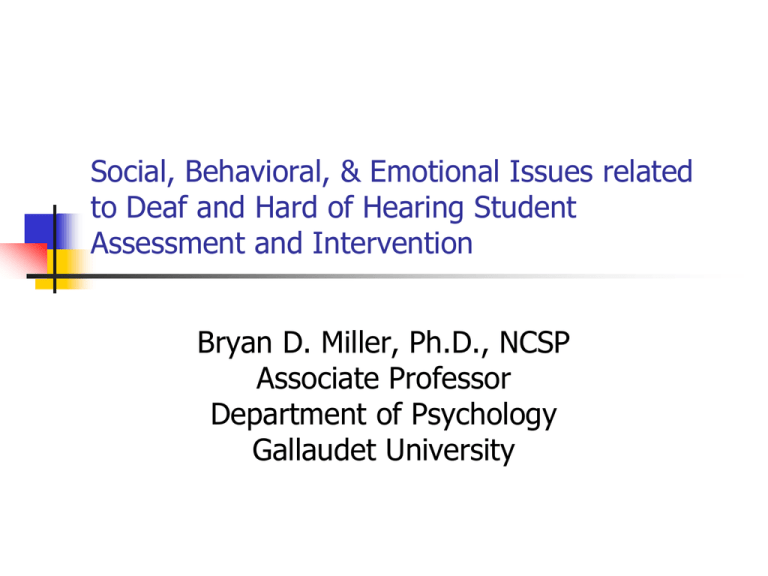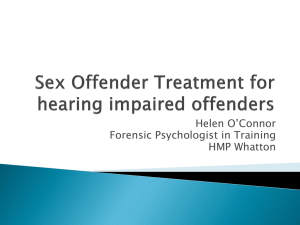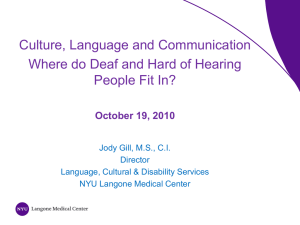
Social, Behavioral, & Emotional Issues related
to Deaf and Hard of Hearing Student
Assessment and Intervention
Bryan D. Miller, Ph.D., NCSP
Associate Professor
Department of Psychology
Gallaudet University
Culturally and Linguistically
Sensitive Behavioral Assessment
Knowledge of the social context, including the family,
the language, and the effects of specific cultural
values and beliefs, needs to be taken into account
among the deaf and hard of hearing (DHH)
population similar to other culturally and linguistically
diverse populations.
Assessment of DHH children as a culturally and
linguistically diverse population for academic
problems as well as behavioral/emotional problems
needs to be carefully planned the same way.
Culturally and Linguistically
Sensitive Behavioral Assessment
Gopaul-McNicol and Thomas-Presswood
(1998) provide an excellent account of
innovative educational approaches when
assessing and providing intervention for
culturally and linguistically diverse children.
Kamphaus and Frick (2002) also provide
important guidelines for assessing children
from diverse backgrounds and for assessing
acculturation as part of evaluating child and
adolescent personality and behavior.
Culturally and Linguistically
Sensitive Behavioral Assessment
Assessment of DHH children needs to pay
careful attention to exclusionary factors when
diagnosing Emotional Disturbance (ED).
Professionals need to attempt to rule out
behavioral characteristics possibly related to
deaf cognition and/or the cultural/linguistic
environment instead of ED characteristics.
Culturally and Linguistically
Sensitive Behavioral Assessment
Assessment that includes, not only standardized
testing, but also includes Response to Intervention
(RTI) approaches will be valuable in the future to
comprehensively address exclusionary factors.
Best practices for DHH will include monitoring
students’ progress as a result of evidence-based
interventions to appropriately rule out
cultural/linguistic environmental and deaf cognitive
biological influences before making an ED diagnosis.
Social, Behavioral, and Emotional
Assessment with Deaf and Hard of
Hearing Children
“Behavior rating scales and
computerized assessments are of
immense value, but the information
that they provide must be interpreted in
the context of an understanding of the
effects of deafness on children’s social
and emotional development”
(Hindley & Kroll, 1998)
Social, Behavioral, and Emotional
Assessment with Deaf and Hard of
Hearing Children
The following recommendations should be taken into
consideration when assessing students:
Basic understanding of behavioral differences of DHH
children.
Test adaptation must be made cautiously.
It is important to use informal assessment and to
observe interactions with children due to the lack of
assessment tools designed for DHH children.
Interpret test results according to what the test
measures and how it applies to DHH children.
Attention Deficit Hyperactivity Disorder
(ADHD) Assessment with Deaf and Hard
of Hearing Students
Problems with DHH children’s development
due to language, communication, and the
environment make the diagnosis difficult.
A number of conditions that can appear like
ADHD or occur in association with ADHD
make it difficult to diagnose ADHD in DHH
children, such as learning disorders,
emotional and behavioral disorders, medical
disorders, and environmental factors.
Attention Characteristics in
DHH Children
It is important for adults working with DHH
students to learn how to work with them
within their visually oriented world
(Marschark & Walters, in Marschark &
Hauser, 2008).
Deaf individuals have a wider field of view
and are sensitive to motion in the periphery
(Bavelier, Dye, & Hauser, 2006) which most
likely helps them attend to more of what is
going on around them (Dye, Hauser, &
Bavelier, in press).
Attention Characteristics in
DHH Children
Differences exist between deaf and hearing parents
and teachers in how they regulate visual attention
and adult/child communication.
Deaf parents and deaf teachers appear to have
knowledge on how to work within DHH students’
zone of proximal development and provide the
appropriate amount of scaffolding, but research has
also shown that hearing mothers who are able to
develop appropriate sign language competency can
communicate with their deaf children similarly to that
of hearing mothers with hearing children (Moeller &
Schick, 2006).
Attention Characteristics in
DHH Children
DHH children have been shown to be
distracted by events in their peripheral vision.
Peripheral input draws their attention away
from the task at hand similar to how hearing
children cannot help but be distracted by
central events.
Research has shown that visual attention
getting and use of visual communication
strategies can be learned (Mohay, 2000).
Attention Characteristics in
DHH Children
Teachers could possibly use computerized training of
attention skills as a part of the students’ classroom
activities.
Klenberg et al. (2001) found that using computerized
visual spatial working memory tasks, while adjusting
the difficulty level as performance increased,
significantly improved performance on working
memory tasks and general reasoning tasks in hearing
children with ADHD.
In addition, their parents reported decreases in
attention difficulties.
Computerized training could be successful for DHH
students who may be struggling with attention.
Attention Characteristics in
DHH Children
Changing the learning environment to
counteract visual distraction needs to be
sensitive to the psychological and cultural
needs of the DHH child.
Change observed in their attention allows
them to adapt to their environment due to
the lack of an auditory sense to inform them
about the environment and to guide their
attention.
Attention Characteristics in
DHH Children
DHH children at the front of the classroom with their
classmates behind them or where they cannot see
out of windows or through the classroom door may
increase difficulties they encounters in school.
This may counter the adaptation in their visual
system and could lead to greater distraction.
This is due to the enhancement in their attentional
peripheral vision which is more evident when the
timing and location of events in the periphery is
unknown.
Attention Characteristics in
DHH Children
One approach could be to allow the DHH
child to learn his visual environment.
Small class sizes with semicircular
arrangement of seats and the same seats for
each student during the year could create a
more predictable learning environment in
which the DHH student can learn to ignore
novel stimuli in their peripheral vision.
Unpredictable events could also be minimized
by decreasing movement in the classroom.
Attention Characteristics in
DHH Children
Research including the participation of deaf children,
deaf adults, and deaf teachers should occur in the
future to help determine how to arrange the physical
layout of classrooms and thus maximize the ability of
the DHH child to attend.
Research on visual attention in DHH children and
adults suggests that the best practices will be those
that support a visually predictable environment in
which DHH students can learn to predict and ignore
task irrelevant stimuli that may distract them from
attending to instruction.
Social and Emotional
Characteristics in DHH Children
Theory of Mind: Deaf and Hearing Children’s
Comprehension of Picture Stories and Judgments of
Social Situations (Rhys-Jones & Ellis, 2000)
The results from this study did not provide evidence
for the hypothesis that deaf adolescents possess
significantly poorer knowledge about social reasoning
than age-matched hearing peers, but it did present
further additional support for Peterson and Siegal’s
(1995) conversational hypothesis: a proposal that a
deprivation in conversation about mental states leads
to an impairment in the development of an
awareness of mental states in the younger deaf
children.
Social and Emotional
Characteristics in DHH Children
PATHS: Promoting Alternative Thinking Strategies (Greenberg
& Kusche, 1998)
PATHS is a comprehensive program that promotes emotional
and social competencies and reduces aggression and behavior
problems in elementary school-aged children.
This program is implemented in the school setting with the
understanding that it should be integrated with the natural
educational process of the classroom.
Designed to be used by educators, counselors, and parents.
Originally developed for used with DHH children but has
subsequently been used with other populations.
PATHS enables students to learn to act and react appropriately
with peers and adults and to control their own behavior.
Social and Emotional
Characteristics in DHH Children
PATHS is a classroom wide prevention curriculum
that includes many aspects of supporting social and
emotional development.
Authors first developed the curriculum with the
objectives to teach DHH children effective
interpersonal problem solving skills.
Their purpose was that the means to achievement of
effective interpersonal problem solving skills is to
build emotional awareness and emotional regulation
skills so that the DHH child uses inner speech to
guide behavioral self control.
Social and Emotional
Characteristics in DHH Children
PATHS is based on cognitive behavioral
principles, including the elements of
cognition, behavior, and affect.
The five domains that the PATH curriculum
addresses are self control, emotional
understanding, interpersonal problem solving
skills, positive self esteem, and peer
communication and relationships.
The lessons are taught three times a week for
20 to 30 minutes for most of the school year
(Greenberg & Kusche, 2006).
Social and Emotional
Characteristics in DHH Children
PATHS curriculum has shown long term effectiveness with
regular education classes (Kelly, Longbottom, Potts, &
Williamson, 2004), special education (Kam, Greenberg, &
Kusche, 2004), and DHH classrooms (Greenberg & Kusche,
1998).
In a follow up to their 1994 study, Greenberg and Kusche
(1998) found that 1 and 2 year post intervention assessments
showed that the deaf children who had participated in the
PATHS program exhibited better problem solving skills, better
social emotional adjustment, and improvements in cognitive
functioning, including less impulsive responding as well as
verbal self direction and planning.
Teachers have commented that the program promoted
language development (Curtis & Norgate, 2007).
All of these positive outcomes are clearly related to social and
emotional development.
Social and Emotional
Characteristics in DHH Children
Executive function (EF) includes the higher order cognitive
processes responsible for metacognition and behavior
regulation, including the control of attention and impulses.
Brain development related to EF begins before birth and
continues until early adulthood.
Research has shown EF is influenced by environmental factors
such as language use at home and in school.
DHH children’s EF appears to follow expected developmental
milestones if they receive appropriate access to language during
the first few years of life and are trained how to use their eyes
more effectively than hearing children to learn from their
environment.
Social and Emotional
Characteristics in DHH Children
Sociocultural approaches to instruction (Rogoff, 1990,
2003; Vygotsky, 1978) provide theory-based teaching
methods that are also evidence-based and shown to
be successful for hearing children.
Sociocultural approaches emphasize ways social
interactions and language use shape students to
become independent learners and facilitate their
cognitive development.
Sociocultural approaches that focus on each child’s
development as social and cultural learners and
thinkers is needed for social and emotional
development.
Social and Emotional
Characteristics in DHH Children
Teacher communication patterns are
influenced by their social and cultural
upbringing.
These sociocultural behaviors have a role in
the classroom because social and
communication interactions shape students
on how to develop learning and thinking skills
(Borkowski & Muthukrishna, 1998; Singleton
& Morgan, 2006).
Research suggests such language and
environmental factors shape EF development.
Social and Emotional
Characteristics in DHH Children
DHH children regardless of the level of their
aided hearing loss depend on visual learning
more than hearing children.
DHH children’s development of visual
attention control as part of EF development is
important to increase their access to
language and incidental learning.
Social and Emotional
Characteristics in DHH Children
Hearing parents could be taught to use visual
attention strategies used in deaf mother deaf
child dyads (Mohay, 2000).
Training could be developed for all teachers
of the deaf from infant toddler programs to
college programs for DHH students.
Training could include strategies
demonstrating how to moderate a classroom
of visual learners.
Example of a DHH Classroom
Behavior Management System
The behavior system uses a timer, cups on the students’ desks,
pennies, and the traffic light poster on the board.
Set the timer for 15 minutes when the students are all in the
room in the morning. Tell the students you are starting the
timer and press the start/stop button.
If a student is not working, not paying attention, not sitting
appropriately, calling out, etc. during the 15 minute time period,
move his/her car to yellow. If the behavior continues or the
student settles down and then starts behaving inappropriately
again, move the car to red. You can quickly/casually mention
the problem, but don’t let the student argue or delay the class
time because of your explanation. When the timer rings, give
each student that is on green or yellow a penny.
Example of a DHH Classroom
Behavior Management System
Re-start the timer, and return all cars to green.
Continue this throughout the entire school day. At
the end of the day, students count their pennies. If
the student has more than 5 pennies and has had a
good day behavior-wise, he/she can pick a prize from
the prize box on the counter.
Do not give pennies to students who are not in the
room (out for mainstream classes). When students
return from the mainstream, ask the interpreters if
they followed the expected behavior. If yes, put a
penny in their cup. If no, no penny.
Suggestions for Improvement
based on DHH Characteristics
Example of a DHH Social Story
School can be a fun place.
When I go to school I get to see my friends and go to gym
class.
I can also learn new things.
We follow rules to keep us safe and to help us learn (such as
Pay Attention and Keep Your Hands and Feet to Yourself).
When we follow the rules, we can get a prize.
I like prizes!
If we follow the rules our names are on the green check.
If we do not follow the rules our names are moved to the red
check.
Example of a DHH Social Story
Sometimes I get mad when my name is moved to the red check or
when the teacher asks me to do something that I do not want to do.
Then I can keep trying hard to follow the rules and earn a green check
(such as Pay Attention and Keep Your Hands and Feet to Yourself).
It is important that I am quiet and I try to relax.
When this happens I will try to keep working and pay attention to the
teacher.
I can take deep breaths to help me relax.
But if I am too upset to keep working the teacher will ask me to take a
break.
When I take a break I can go to the “time out chair”.
When I go there I can take deep breaths.
And count to 10 in my mind.
I also need to draw a picture of what happened.
And then I draw a picture of what I could have done better.
Suggestions for Improvement
based on DHH Characteristics
Example of a DHH Crisis
Management Plan
The following crisis management procedures will be used when A is
engaged or about to engage in aggressive behavior that has the
potential of injuring others and/or when he is engaged or about to
engage in destructive behavior that has the potential of doing
substantial property damage.
A will be directed to a designated seclusion/timeout area and required
to remain in this area without positive reinforcement and without other
reinforcing activities until he is calm.
A staff member must make visual contact with A every 2 minutes.
Include a release contingency—additional period of time for calm
behavior (between 10 seconds and 5 minutes) before release from
seclusion/timeout.
Do not exceed 15 minutes for the total duration of the procedure.
Example of a DHH Crisis
Management Plan
After 5 minutes of refusing to do work or complying with other
demands, prompt A to sit in “time out” chair and complete a yellow
form. A should be seated with his back to the class until he has
completed the yellow form and calmed himself. Set ‘time out’ timer to
5 minutes. Tell him that after the timer rings, if he is filling out his
sheet and sitting quietly, he will be able to return to the group and his
name will be moved to the ‘yellow’ area.
Continue teaching other students and encourage them to ignore the
behaviors.
If A continues to become too distracting and/or leaves his chair and
begins to throw things, hit himself, pound his fists, etc., then after 5
minutes have the Para remove the other children from the room and
have them work on their “packets.” After the students leave, set the
‘time out’ timer for another 5 minute period. For the duration of his
behavior, up to 15 minutes, continue to reset the timer and let him
know that he has another chance to calm himself and comply with the
expectation(s).
Example of a DHH Crisis
Management Plan
Call designated related services personnel to report that the behaviors
are occurring and to see if she is able to offer any support and/or can
come to process the incident with A once behaviors have diminished.
Teacher stays in the room with A and encourages him to sit in the
time-out chair and clearly and simply states expectations “sit down and
take 10 deep breaths” (or whatever the request is at the moment) as
opposed to having him attempt to engage teacher’s attention.
If A ignores teacher’s prompts then teacher should ignore student
behavior and work on an alternate activity, resetting the timer for 5
minute intervals, as needed, until 15 minutes have elapsed.
After a few minutes teacher should again clearly and simply state
expectation (e.g., “sit down and take 10 deep breaths”). (This
continues until A complies or for no longer than 15 minutes.)
The only contact between teacher and student should be teacher clearly
and simply stating expectation (e.g., “sit down and take 10 deep breaths”).
Example of a DHH Crisis
Management Plan
If A complies and is seated, he returns to his desk and teacher
presents him with the activity he missed/refused to complete, then
informs him that the timer will start again and now, if he has positive
behavior, he can earn a green check.
After A complies for 5 minutes in his seat, the other students can
return to the classroom.
However, if A does not comply and 15 minutes have elapsed, then seek
assistance from the building principal, counselor, school psychologist,
or other related services personnel. Ask principal to remove student to
office. Do not give A any attention while in office until negative
behaviors have decreased.
Principal/teacher can call parent to discuss situation.
Return A to classroom and have him fill in a yellow form (what I did
and what I should have done) and process event and possible (+)
reactions with teacher/ social worker.
Suggestions for Improvement
based on DHH Characteristics
DHH Case Study
The IU 13 school psychologist observed A’s classroom on 9/15/08 from 11:15 a.m. to 12:45
p.m. to assist with identifying target behaviors and behavioral functions. Using a 1 minute
time sampling procedure for all observations, A demonstrated 80% on-task behavior in a
small group reading class (3 students) for 10 minutes, with 2 intervals of passive and motor
off-task behavior exhibited as A looked at the floor and touched another student sitting next
to him on the carpet (attention function), which was followed by the student moving away
from him with no further off-task behavior exhibited by A. Specific academic behavior
included A counting his reading cards he collected after correctly identifying words. After a
20 minute period of 1-1 reading instruction, A transitioned to a 10 minute independent
writing activity and demonstrated 90% on-task behavior, with 1 interval of motor off-task
behavior as A rolled up the paper he was supposed to be writing words on (attention
function), although he stopped with signed redirection. When A’s speech and language
therapist arrived to take A for speech and language therapy, A originally said that he did
not have his speech folder in an apparent attention function, although the speech and
language therapist found it. A then stood by the door and did not initially move to leave
the classroom (attention function), needing a signed and physical prompt (hand on back) to
walk. After returning to the classroom in 30 minutes, A transitioned to another small group
(4 students) activity involving writing and presenting. A demonstrated 88% on-task
behavior for the 25 minute activity, with 3 intervals of motor off-task behavior as he looked
at this examiner and poked his pencil into his belly in an apparent attention function.
Again, he stopped with a signed redirection to continue writing. Additional on-task
behaviors noted during this activity included participating in the lesson by describing what
he had included in a poster he made, and following teacher directions to begin writing. A
did also demonstrate restless, squirmy behavior during 1 separate interval, but this
behavior did not escalate into increasingly off-task behavior or aggressive non-compliance.
DHH Case Study
The school psychologist used a Structured ABC Analysis Form on 9/15/08 to
further identify locations, antecedents, and consequences of 5 separate
observed problem behaviors. Touching another student included an antecedent
of the student sitting next to A and included the consequence of the student
moving away, which discontinued the behavior. Sniffing his book and pointing
to something in the book (which occurred during 1-1 reading instruction)
included demand antecedents of the teacher questioning him about a story, with
redirection effectively being used as a consequence to stop the behavior.
Rolling his paper also included demand antecedents, again with an effective
redirection consequence. Standing still instead of walking to speech and
language therapy included an antecedent of receiving attention for misplacing
his folder and included the consequence of attention for his standing still
behavior. In all, 4/5 behaviors included a 1-1 interaction between
teacher/therapist and student, with 1/5 taking place in small group. 3/5
involved demands as antecedents and 2/5 involved approach/attention.
Redirection was identified as an effective consequence, with ignoring also
effective in stopping the behavior, but attention/approach less successful in
reducing attention-seeking behavior for A.
DHH Case Study
A’s teacher completed the FAST throughout 9/08 to identify primary functions of
behaviors following problem behavioral incidents which occurred on 9/9, 9/10,
9/12, and 9/29. The target behavior identified included aggression, specifically
screaming, stomping, clenching fists, and rolling back his eyes in his head. The
frequency of these behaviors was identified to be daily, with severity noted as
mild as it was disruptive but involved little risk to property or health. Identified
times that problem behavior was most likely to occur included 11:00 to 12:30,
while settings/activities problem behavior was least likely to occur included
specials and recess. Before the problem behavior occurs, A reportedly usually
refuses to follow a direction that is either challenging for him or something he
doesn’t want to do. After the problem behavior occurs, A reportedly usually
rejoins the activity. The FAST revealed a mixture of social positive
(attention/preferred items) and negative (escape from tasks/activities)
reinforcement as primary functions of A’s behaviors, but further interpretation
revealed a stronger attention function as compared to escape due to his
tendency to return to work on his own time if ignored (withdrawal of attention)
and his tendency to act silly and rowdy during down time when he is not
required to do anything (absence of demands).
DHH Case Study
Target Behaviors:
DHH Case Study
Immediate Triggers:
DHH Case Study
Function of Behavior:
DHH Case Study
Description of Behavior:
DHH Case Study
Alternative Skills to be Taught:
DHH Case Study
Consequence Strategies:
To reinforce the alternative skills:
DHH Case Study
Consequence Strategies:
To decrease target behaviors:
DHH Case Study
Classroom Interventions to
Reinforce Skills:
DHH Case Study
Monitoring/Evaluation:
Social Processes and Outcomes of In-School
Contact Between Deaf and Hearing Peers
(Kluwin, Stinson, & Colarossi, 2002)
Social Skills/Social Maturity:
In regard to the question of whether deaf students demonstrate
age-appropriate social behavior, the studies suggest that middle
school hearing peers may be more socially mature than deaf
peers, but differences between the peer groups are apparent
only when teacher evaluations of social maturity are used.
In addition, one study indicated that adolescent mainstreamed
deaf students are more socially mature than self-contained deaf
students, but deaf students are selected for mainstream classes
on the basis of their social maturity. The difference in the age
range of the participants may also have affected the results.
Social Processes…
Social Interaction:
For observational studies, there appear to be fairly
consistent patterns in the interactions between deaf
and hearing peers.
Deaf students tend to interact more frequently with
deaf classmates than with hearing ones. In addition,
exposure of deaf and hearing peers to each other
over time may increase interactions.
Studies also indicate that specially designed
interventions, such as certain types of cooperative
learning, can increase interaction.
Social Processes…
These social interaction studies have collectively employed a
variety of age groups, observational systems, settings, and
experimental manipulations.
Results regarding self-reports of participations, conducted
primarily with adolescents, are in some respects similar to those
for the observational studies, conducted primarily with young
children.
Deaf students generally report themselves as interacting more
often with like peers, in line with the findings for observational
studies.
Self-report studies have also shown, as have observational
studies, that deaf students’ participation in social activities with
hearing classmates may increase when these groups have
greater contact with each other.
Social Processes…
Social Acceptance:
Studies with measures of peer rated acceptance,
conducted with a variety of age groups, have yielded
mixed findings.
Results for three studies indicated that hearing peers
accepted deaf students in mainstream classes,
although factors such as extent of contact and
gender may have an effect.
In a fourth study, however, the deaf students were
not as accepted as the hearing students and an
intervention had no effect.
Social Processes…
The social acceptance studies of self-perceptions of relatedness
suggest a different perspective on acceptance.
Even though in the above studies hearing peers often showed
acceptance in their ratings, the deaf students may have viewed
their relationships with hearing peers as less than fully
satisfying.
The Musselman et al. (1996), Stinson and Whitmire (1991), and
Stinson et al. (1996) studies suggest that, in general, deaf
students report greater relatedness with deaf peers than with
hearing ones.
Adolescents were the participants in these studies and a
qualification here is that perceptions may vary as a function of
extent of mainstreaming and characteristics of the sample.
Social Processes…
Social acceptance results for perceptions of relatedness also differed
from those for perceptions of participation.
Although reported participation increased with greater contact between
deaf and hearing peers, relatedness often seemed to be independent
of participation.
The relationship might be summarized by the adolescents most often
studied this way as “I like them alright, but I’d prefer my own kind if I
have a choice.”
Some of this may be an effect of studying adolescents who place so
much emphasis on personal discovery and definition through peer
interaction and thus would prefer a like group as a benchmark; or it
may be a more general human phenomenon paralleling the
preferences of the preschoolers who would rather interact with
someone of the same race, sex, age, and hearing status.
Finally, the pattern of results may also reflect the effect of the frequent
difficulties deaf and hearing students have in communicating with each
other and establishing close relationships.
Social Processes…
Affective Functioning:
The studies reviewed indicate no general difference in selfperceived self-image, or self-esteem, as a function of
segregated versus mainstream classes.
A qualification here is that rated self-image may vary with the
setting when the child’s language skills are taken into
consideration as well.
A change in the setting, such as from a school with only deaf
students to one with both deaf and hearing students, may also
affect self image.
Perceived social competence may also vary with the setting,
except in this case, age needs to be taken into consideration as
well.
An additional consideration is the age of the participants, as the
studies used primarily adolescents for their sample.
Implications of Social
Processes…
Social measures are of direct relevance to educators
working with deaf and hard-of-hearing students in
classes with hearing peers.
Measures are needed to help determine, from a
social perspective, appropriate placement for the
individual student.
Measures can also monitor the social development of
that student in the placement.
Measures can additionally assess the effectiveness of
interventions designed to facilitate the social
integration of the student.
Promoting Social Competence in Deaf
Students: The Effect of an Intervention
Program (Suarez, 2000)
The aim of this study was to determine the effects of a social skills
training program on the social skills and social behaviors of deaf
children in a mainstream setting.
The study used a pretest/posttest design.
The participants consisted of 18 severely and profoundly hearingimpaired children (ages ranged from 9-1 to 13-6) who were enrolled in
three elementary schools in the Canary Islands.
Results indicated that the intervention succeeded in improving
students’ social problem-solving skills, especially in making
comprehensible the steps implied in the solution of interpersonal
problems; the intervention also led to significant improvement of deaf
students’ assertive behavior as rated by their teachers and by
themselves.
Significant differences in social or academic integration as judged by
companions in a sociometric questionnaire were not found.
Promoting Social
Competence…
The format for teaching social skills followed in each
session was derived from the literature in this field
(Goldstein, Sprafkin, Gershaw, & Klein, 1980;
Michelson, Sugay, Wood, & Kazdin, 1983) and
consisted of the following:
Introduction to the skill and instructions.
Modeling.
Role-playing.
Feedback and reinforcement.
Discussion.
Home activities.
Generalization.
Promoting Social
Competence…
The following three types of measures were
obtained: ratings made by teachers, sociometric
measures, and self-ratings completed by the deaf
students.
The Meadow/Kendall Social-Emotional Assessment
Inventory for Deaf Students (MKSEAI; Meadow,
1983).
The teacher ratings: Children’s Assertive Behavior
Scale (CABS; Michelson et al., 1983).
The Sociometric Questionnaire (Gosalbez, 1980).
The deaf student’ self-ratings: Children’s Assertive
Behavior Scale (Self-CABS).
Hearing Mothers and Their Deaf Children: The
Relationship between Early, Ongoing Mode Match and
Subsequent Mental Health Functioning in Adolescence
(Wallis, Musselman, and MacKay, 2004)
In the few studies that have been conducted, researchers have
typically found that deaf adolescents have more mental health
difficulties than their hearing peers and that, within the deaf groups,
those who use spoken language have better mental health functioning
than those who use sign language.
This study investigated the hypotheses that mental health functioning
in adolescence is related to an early and consistent mode match
between mother and child rather than to the child’s use of speech or
sign itself.
Using a large existing 15-year longitudinal database on children and
adolescents with severe and profound deafness, 57 adolescents of
hearing parents were identified for whom data on language experience
(the child’s and the mother’s) and mental health functioning (from a
culturally and linguistically adapted form of the Achenbach Youth Self
Report) was available.
Hearing Mothers…
Three groups were identified: auditory/oral (A/O),
sign match (SM), and sign mismatch (SMM).
As hypothesized, no significant difference was found
favoring a combined A/O and SM groups, but a
significant difference was found favoring a combined
A/O and SM group over the SMM group.
These results support the notion of the importance of
an early and consistent mode match between deaf
children and hearing mothers, regardless of
communication modality.
Parenting Stress and Social Support in Hearing Mothers
of Deaf and Hearing Children: A Longitudinal Study
(Lederburg & Goldbach, 2002)
This longitudinal study investigated the impact of child deafness on
mothers’ stress, size of social networks, and satisfaction with social
support.
23 hearing mothers of deaf children and 23 hearing mothers of hearing
children completed a series of self report questionnaires when their
children were 22 months, 3, and 4 years old.
When children were 22 months, more mothers of deaf children
reported pessimism about their children’s achieving self-sufficiency and
concerns about their children’s communication abilities than did
mothers of hearing children.
When their children were 3 and 4 years old, mothers of deaf and
hearing children did not differ in their reports of general parenting
stress, as measured by the Parenting Stress Index (PSI).
Likewise, mothers’ ratings of satisfaction with social support were not
affected by child deafness, nor did they change developmentally.
Parenting Stress…
Mothers of deaf and hearing children did differ in the types of support
networks utilized.
Mothers of deaf 22-month-olds reported significantly larger
professional support networks, while mothers of hearing children
reported significantly larger general support networks across all child
ages.
Mothers’ feelings of stress and satisfaction with social support were
very stable across the 2 years examined.
The results suggest that most mothers of deaf children do not feel a
high level of general parenting stress or dissatisfaction with their lives
and support networks.
However, mothers of deaf children are likely to feel stress in areas
specific to deafness. In addition, because parenting stress was highly
stable, special efforts should be made to intervene when mothers of
deaf children are expressing high levels of stress.







